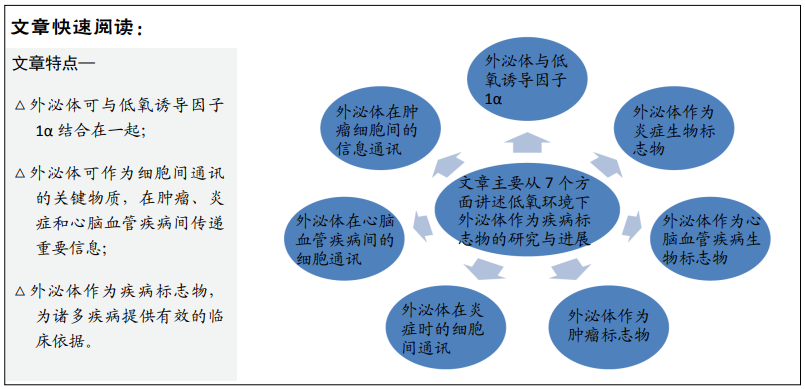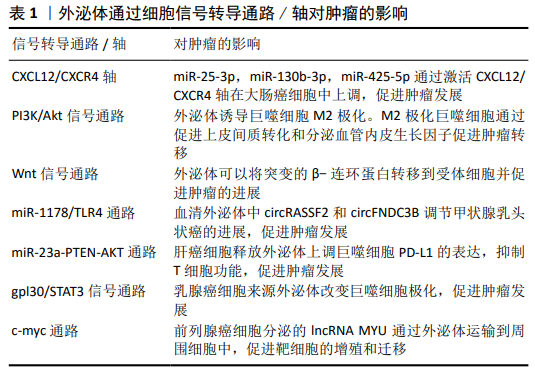[1] JOHNSTONE RM, ADAM M, HAMMOND JR, et al. Vesicle formation during reticulocyte maturation. Association of plasma membrane activities with released vesicles (exosomes). J Biol Chem. 1987;262(19):9412-9420.
[2] PIRONTI G, STRACHAN RT, ABRAHAM D,et al. Circulating Exosomes Induced by Cardiac Pressure Overload Contain Functional Angiotensin II Type 1 Receptors. Circulation. 2015;131(24):2120-2130.
[3] YANG J, WEI F, SCHAFER C, et al. Detection of tumor cell-specific mRNA and protein in exosome-like microvesicles from blood and saliva. PLoS One. 2014;9(11):e110641.
[4] HO DH, YI S, SEO H, et al. Increased DJ-1 in urine exosome of Korean males with Parkinson’s disease. Biomed Res Int. 2014;2014:704678.
[5] WANG T, GILKES DM, TAKANO N, et al. Hypoxia-inducible factors and RAB22A mediate formation of microvesicles that stimulate breast cancer invasion and metastasis. Proc Natl Acad Sci U S A. 2014;111(31): E3234-3242.
[6] ZHAO L, LUO H, LI X, et al. Exosomes Derived from Human Pulmonary Artery Endothelial Cells Shift the Balance between Proliferation and Apoptosis of Smooth Muscle Cells. Cardiology. 2017;137(1):43-53.
[7] SANO S, IZUMI Y, YAMAGUCHI T, et al. Lipid synthesis is promoted by hypoxic adipocyte-derived exosomes in 3T3-L1 cells. Biochem Biophys Res Commun. 2014;445(2):327-333.
[8] BORGES FT, MELO SA, ÖZDEMIR BC, et al. TGF-β1-containing exosomes from injured epithelial cells activate fibroblasts to initiate tissue regenerative responses and fibrosis. J Am Soc Nephrol. 2013;24(3):385-392.
[9] AGARWAL U, GEORGE A, BHUTANI S, et al. Experimental, Systems, and Computational Approaches to Understanding the MicroRNA-Mediated Reparative Potential of Cardiac Progenitor Cell-Derived Exosomes From Pediatric Patients. Circ Res. 2017;120(4):701-712.
[10] LV B, LI F, FANG J, et al. Hypoxia inducible factor 1α promotes survival of mesenchymal stem cells under hypoxia. Am J Transl Res. 2017;9(3): 1521-1529.
[11] LI ZL, LV LL, TANG TT, et al. HIF-1α inducing exosomal microRNA-23a expression mediates the cross-talk between tubular epithelial cells and macrophages in tubulointerstitial inflammation. Kidney Int. 2019;95(2): 388-404.
[12] ZHANG W, ZHOU X, YAO Q, et al. HIF-1-mediated production of exosomes during hypoxia is protective in renal tubular cells.Am J Physiol Renal Physiol. 2017;313(4):F906-F913.
[13] ERDBRÜGGER U, LE TH. Extracellular Vesicles in Renal Diseases: More than Novel Biomarkers? J Am Soc Nephrol. 2016;27(1):12-26.
[14] KARPMAN D, STÅHL AL, ARVIDSSON I. Extracellular vesicles in renal disease. Nat Rev Nephrol. 2017;13(9):545-562.
[15] CHEN X, ZHOU J, LI X, et al. Exosomes derived from hypoxic epithelial ovarian cancer cells deliver microRNAs to macrophages and elicit a tumor-promoted phenotype. Cancer Lett. 2018;435:80-91.
[16] ZHANG Y, HAO Z, WANG P, et al. Exosomes from human umbilical cord mesenchymal stem cells enhance fracture healing through HIF-1α-mediated promotion of angiogenesis in a rat model of stabilized fracture. Cell Prolif. 2019;52(2):e12570.
[17] VALADI H, EKSTRÖM K, BOSSIOS A, et al. Exosome-mediated transfer of mRNAs and microRNAs is a novel mechanism of genetic exchange between cells. Nat Cell Biol. 2007;9(6):654-659.
[18] SKOG J, WÜRDINGER T, VAN RIJN S, et al. Glioblastoma microvesicles transport RNA and proteins that promote tumour growth and provide diagnostic biomarkers. Nat Cell Biol. 2008;10(12):1470-1476.
[19] SMYTHIES J, EDELSTEIN L. Transsynaptic modality codes in the brain: possible involvement of synchronized spike timing, microRNAs, exosomes and epigenetic processes. Front Integr Neurosci. 2013;6:126.
[20] TAYLOR DD, GERCEL-TAYLOR C. The origin, function, and diagnostic potential of RNA within extracellular vesicles present in human biological fluids. Front Genet. 2013;4:142.
[21] XU D, TAHARA H. The role of exosomes and microRNAs in senescence and aging. Adv Drug Deliv Rev. 2013;65(3):368-375.
[22] HAN Q, LV L, WEI J, et al. Vps4A mediates the localization and exosome release of β-catenin to inhibit epithelial-mesenchymal transition in hepatocellular carcinoma. Cancer Lett. 2019;457:47-59.
[23] CHEN W, QUAN Y, FAN S, et al. Exosome-transmitted circular RNA hsa_circ_0051443 suppresses hepatocellular carcinoma progression. Cancer Lett. 2020;475:119-128.
[24] WU DM, WEN X, HAN XR, et al. Bone Marrow Mesenchymal Stem Cell-Derived Exosomal MicroRNA-126-3p Inhibits Pancreatic Cancer Development by Targeting ADAM9. Mol Ther Nucleic Acids. 2019;16:229-245.
[25] YUE X, LAN F, XIA T. Hypoxic Glioma Cell-Secreted Exosomal miR-301a Activates Wnt/β-catenin Signaling and Promotes Radiation Resistance by Targeting TCEAL7. Mol Ther. 2019;27(11):1939-1949.
[26] WANG D, WANG X, SI M, et al. Exosome-encapsulated miRNAs contribute to CXCL12/CXCR4-induced liver metastasis of colorectal cancer by enhancing M2 polarization of macrophages. Cancer Lett. 2020;474:36-52.
[27] KALRA H, GANGODA L, FONSEKA P, et al. Extracellular vesicles containing oncogenic mutant β-catenin activate Wnt signalling pathway in the recipient cells. J Extracell Vesicles. 2019;8(1):1690217.
[28] CHEN F, CHEN J, YANG L, et al. Extracellular vesicle-packaged HIF-1α-stabilizing lncRNA from tumour-associated macrophages regulates aerobic glycolysis of breast cancer cells. Nat Cell Biol. 2019;21(4):498-510.
[29] WU G, ZHOU W, LIN X, et al. circRASSF2 Acts as ceRNA and Promotes Papillary Thyroid Carcinoma Progression through miR-1178/TLR4 Signaling Pathway. Mol Ther Nucleic Acids. 2020;19:1153-1163.
[30] WU G, ZHOU W, PAN X, et al. Circular RNA Profiling Reveals Exosomal circ_0006156 as a Novel Biomarker in Papillary Thyroid Cancer. Mol Ther Nucleic Acids. 2020;19:1134-1144.
[31] LIU J, FAN L, YU H, et al. Endoplasmic Reticulum Stress Causes Liver Cancer Cells to Release Exosomal miR-23a-3p and Up-regulate Programmed Death Ligand 1 Expression in Macrophages. Hepatology. 2019;70(1):241-258.
[32] HAM S, LIMA LG, CHAI EPZ, et al. Breast Cancer-Derived Exosomes Alter Macrophage Polarization via gp130/STAT3 Signaling. Front Immunol. 2018; 9:871.
[33] WANG J, YANG X, LI R, et al. Long non-coding RNA MYU promotes prostate cancer proliferation by mediating the miR-184/c-Myc axis. Oncol Rep. 2018; 40(5):2814-2825.
[34] GAO L, MEI S, ZHANG S, et al. Cardio-renal Exosomes in Myocardial Infarction Serum Regulate Proangiogenic Paracrine Signaling in Adipose Mesenchymal Stem Cells. Theranostics. 2020;10(3):1060-1073.
[35] WANG SY, LI Y, JIANG YS, et al. Investigation of serum miR-411 as a diagnosis and prognosis biomarker for non-small cell lung cancer. Eur Rev Med Pharmacol Sci. 2017;21(18):4092-4097.
[36] TONG Y, YE C, REN XS, et al. Exosome-Mediated Transfer of ACE (Angiotensin-Converting Enzyme) From Adventitial Fibroblasts of Spontaneously Hypertensive Rats Promotes Vascular Smooth Muscle Cell Migration. Hypertension. 2018;72(4):881-888.
[37] XU F, ZHONG JY, LIN X, et al. Melatonin alleviates vascular calcification and ageing through exosomal miR-204/miR-211 cluster in a paracrine manner. J Pineal Res. 2020;68(3):e12631.
[38] GUPTA R, RADICIONI G, ABDELWAHAB S, et al. Intercellular Communication between Airway Epithelial Cells Is Mediated by Exosome-Like Vesicles. Am J Respir Cell Mol Biol. 2019;60(2):209-220.
[39] JIANG K, YANG J, GUO S, et al. Peripheral Circulating Exosome-Mediated Delivery of miR-155 as a Novel Mechanism for Acute Lung Inflammation. Mol Ther. 2019;27(10):1758-1771.
[40] 刘超.血清来源的外泌体对BEAS-2B细胞气道炎症相关因子表达和TLR4/NF-κB炎症信号通路的影响[D]. 南昌:南昌大学,2019.
[41] WANG Y, ZHENG F, GAO G, et al. MiR-548a-3p regulates inflammatory response via TLR4/NF-κB signaling pathway in rheumatoid arthritis. J Cell Biochem. 2019;120(2): 1133-1140.
[42] CHEN CW, FU M, DU ZH, et al. Long Noncoding RNA MRPL23-AS1 Promoteoid Cystic Carcinoma Lung Metastasis. Cancer Res. 2020 Feb 25. doi: 10.1158/0008-5472.CAN-19-0819. Online ahead of print.
[43] 吴锋,王翠香,田华.肝细胞癌患者血清外泌体LncRNAZFAS1表达临床意义[J].中华肿瘤防治杂志, 2019,26(12):849-854.
[44] HUANG L, WANG Y, CHEN J, et al. Long noncoding RNA PCAT1, a novel serum-based biomarker, enhances cell growth by sponging miR-326 in oesophageal squamous cell carcinoma. Cell Death Dis. 2019;10(7):513.
[45] HU D, ZHAN Y, ZHU K, et al. Plasma Exosomal Long Non-Coding RNAs Serve as Biomarkers for Early Detection of Colorectal Cancer. Cell Physiol Biochem. 2018;51(6):2704-2715.
[46] 张好良,蔡晨晨,张苗苗.血清外泌体源性长链非编码RNA RPN2-4在胃癌中的表达及其筛查价值[J]. 临床检验杂志, 2019,37(5):331-333.
[47] SU YY, SUN L, GUO ZR, et al. Upregulated expression of serum exosomal miR-375 and miR-1307 enhance the diagnostic power of CA125 for ovarian cancer. J Ovarian Res. 2019;12(1):6.
[48] ZHENG M, HOU L, MA Y, et al. Exosomal let-7d-3p and miR-30d-5p as diagnostic biomarkers for non-invasive screening of cervical cancer and its precursors. Mol Cancer. 2019;18(1):76.
[49] 魏萍,杜鲁涛,王卿,等.血清外泌体miR-20b-5p对非小细胞肺癌的诊断价值[J].山东大学学报(医学版), 2019, 57(4):91-96.
[50] MIN L, ZHU S, CHEN L, et al. Evaluation of circulating small extracellular vesicles derived miRNAs as biomarkers of early colon cancer: a comparison with plasma total miRNAs. J Extracell Vesicles. 2019;8(1):1643670.
[51] SHAO N, XUE L, WANG R, et al. miR-454-3p Is an Exosomal Biomarker and Functions as a Tumor Suppressor in Glioma. Mol Cancer Ther. 2019; 18(2):459-469.
[52] 张海涛,林文勇 解曼曼.冠心病患者外周血外泌体中microRNA基因芯片的差异性表达[J]. 临床心血管病杂志, 2019,35(6):501-505.
[53] LI H, LIAO Y, GAO L, et al. Coronary Serum Exosomes Derived from Patients with Myocardial Ischemia Regulate Angiogenesis through the miR-939-mediated Nitric Oxide Signaling Pathway. Theranostics. 2018;8(8): 2079-2093.
[54] YANG J, YU XF, LI YY, et al. Decreased HSP70 expression on serum exosomes contributes to cardiac fibrosis during senescence. Eur Rev Med Pharmacol Sci. 2019;23(9):3993-4001.
[55] 宋晓菲,徐元宏.丙型肝炎病毒感染患者血清外泌体miR-122的表达量及临床意义探讨[J]. 安徽医科大学学报, 2019, 54(1):131-134.
[56] FENG Y, LV LL, WU WJ, et al. Urinary Exosomes and Exosomal CCL2 mRNA as Biomarkers of Active Histologic Injury in IgA Nephropathy. Am J Pathol. 2018;188(11):2542-2552.
[57] LIAO TL, HSIEH SL, CHEN YM, et al. Rituximab May Cause Increased Hepatitis C Virus Viremia in Rheumatoid Arthritis Patients Through Declining Exosomal MicroRNA-155. Arthritis Rheumatol. 2018;70(8):1209-1219. |

